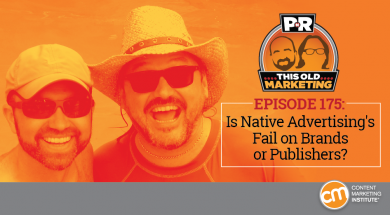PNR: This Old Marketing with Joe Pulizzi and Robert Rose can be found on both iTunes and Stitcher.
In this episode, Robert and I dissect the latest native advertising research to see whether this technique is gaining ground or losing fans. We also explore some optimistic CMO research, and explain why technology and analytics will save the day. Our rants and raves cover simplification and measuring bodies, then we take on March Madness in our example of the week.
This week’s show
(Recorded live on March 20, 2017; Length: 1:05:21)
Download this week’s PNR This Old Marketing podcast.
If you enjoy our PNR podcasts, we would love if you would rate it, or post a review, on iTunes.
1. Notable news and upcoming trends
- Evidence is mounting that native advertising doesn’t work… (09:16): Media Life Magazine reports on a new study by MediaRadar, which finds that, despite significant gains in native ad spending over the past few years, two-thirds of advertisers who try the technique ultimately abandon it.
- … but could campaign length be the answer that turns it all around?(10:24): Meanwhile, AdAge offers an alternative view of the MediaRadar’s findings. It focuses on a key reason why some outlets — The Wall Street Journal, for instance — may be able to achieve advertiser renewal rates of 72% for their native advertising campaigns: They run their campaigns for longer periods of time. Among the bigger issues that we see here is that advertisers’ expectations with native advertising seem to be unrealistic in terms of volume and velocity. Robert and I would also be curious to see how native advertising’s renewal rates might compare to those of other ad techniques.
How Does Native Advertising Fit in a Content Marketing Strategy?
- Marketers to spend on analytics, though their use remains elusive (25:25): The CMO Survey has released its latest report, which anticipates that spending on marketing analytics will grow to nearly 22 percent of marketing budgets in the next three years — representing a 376% increase. At the same time, marketers say barely a third of available data is used to drive decision-making in their companies. I’ve been following this report for years and I’ve never seen CMO optimism so high — which could be a sign of a bubble that’s about to burst. But what’s an even bigger red flag for me is that CMOs are continuing to place so much more emphasis on acquisition than on retention.
2. Sponsor (36:46)
- Parse.ly – Getting There: How Brands, Publishers, and Agencies Use Content Analytics: With content creation and promotion comes a lot of data. If you have a digital audience, there’s a good chance that you have trouble connecting the information your data provides with a way to use it to improve your content strategy. Don’t worry — you’re not alone. Parse.ly (the company, not the herb) has researched the state of content analytics with a survey of publishers, brands — anyone that creates content. The report they produced on the findings reveals what metrics the industry considers most useful, the siloed state of brand and publisher offices when it comes to data access, and how their analytics end up impacting the content they create. Get it now.
3. Rants and raves (39:10)
- Joe’s rave No. 1: Netflix has just introduced a handy new feature: With the click of a button, you can skip through the opening credits of any TV show or movie. Entertainment brands, take note: My son (a member of Generation Z), who pointed out the new technology to me, thinks it’s the best invention ever.
- Joe’s rave No. 2: Actor and comedian Jerrod Carmichael recently remarked in an interview that he eats scrambled eggs with walnuts and blueberries for breakfast every day, because streamlining this decision-making process frees up more energy that he can spend on honing his craft. It’s a brilliant strategy that I would like to recommend to all content marketers. If there’s even one personal process you can put on autopilot, it will free up valuable mind space, which can lead to unexpected creative opportunities.
Put one personal process on autopilot to free up valuable mind space, says @joepulizzi.
Click To Tweet
- Robert’s commentary: Robert’s been thinking about a critical industry change that no one seems to be covering in a meaningful way. AdAge has touched on the issue with its recent post on Procter & Gamble’s threat to stop spending money on digital platforms that don’t receive audience measurement accreditation by the Media Rating Council (MRC) by year’s end. Of the major media players (Facebook, Google, Snapchat, Pinterest, and Twitter), only Google has begun the audits necessary to comply with P&G’s demands. But what Robert sees as the bigger story here is the potential for a complete disruption to the third-party measurement platforms themselves. It begs the question: Will there still be such a thing as an agreed-upon industry standard for measurement when this all comes to a head?
4. This Old Marketing example of the week (56:05)
- Though it’s a departure from the types of examples we typically discuss in This Old Marketing, I hope you will indulge my recent curiosity about how March Madness came about, given the media frenzy that surrounds this annual event. According to an article I found on legal site Baker Botts, the Illinois High School Association (IHSA) first used the term in an essay as early as 1939, in reference to an annual basketball tournament that routinely drew sellout crowds. This continued until 1982, when a CBS reporter from Chicago began using the phrase to describe the NCAA men’s Division I basketball tournament. This set off a slew of trademark disputes, which raged until February 29, 2000, when the IHSA and NCAA pooled their trade and service mark resources and formed an LLC — the March Madness Athletic Association (MMAA). Pursuant to their agreement, MMAA now jointly owns the rights to all profits from the March Madness trademark. I think it’s fascinating that a term that’s virtually synonymous with college basketball originated in high school athletics. But beyond that, it’s also an intriguing example of an organization that could create a content brand, build traction over time, and then find ways to monetize the audience’s engagement.
For a full list of PNR archives, go to the main This Old Marketing page.
Cover image by Joseph Kalinowski/Content Marketing Institute
How do I subscribe?
The post This Week in Content Marketing: Is Native Advertising’s Fail on Brands or Publishers? appeared first on Content Marketing Institute.





No comments:
Post a Comment